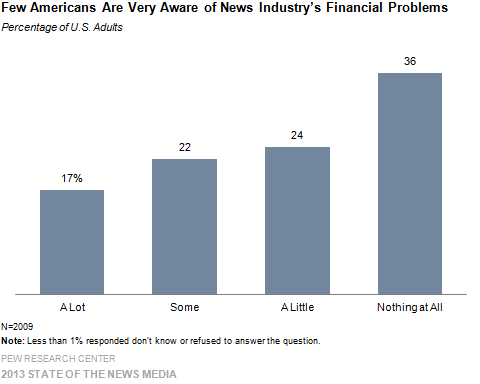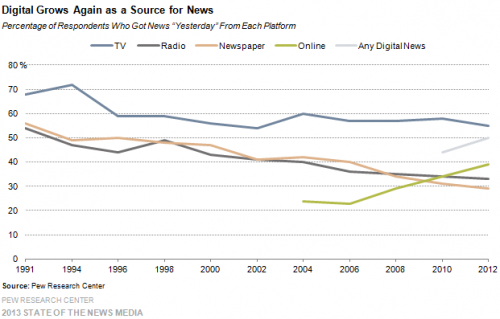The Case of the Disappearing Professional Media Photographer?
Cause the good ole days weren’t always good,
And tomorrow ain’t as bad as it seems.”
Keeping The Faith
– Billy Joel
The Chicago Sun-Times’ decision to lay off its staff of photographers and editors (~28 total), including a Pulitzer Prize winner, sent shock waves throughout the photography industry. Some cried foul. Some expressed disbelief. Others lamented the changing times and the commoditization of the professional media photography field. Many mocked the paper’s suggestion that it would rely on reporters to take their own photos using iPhones and DSLRs. The Sun-Times did not eliminate using professional photographers, since it plans on using some freelancers to fill some of the void created by the departure of the full-time professional crew. But the Sun-Times’ announcement was a clear indication that it believe something had fundamentally changed and it was willing to take radical action to do what it thought best for the immediate and long-term health of the business.


When changes are gradual, we notice them less. It is only after some extended period of time that we reflect on how much things have diverged from their previous state. The Sun-Times’ announcement had all the subtlety of a nuclear bomb. The reason for the widespread attention was that it put the issue, regarding the how deeply and rapidly our society is being transformed by technological and cultural changes, right in front of our face. The Sun-Times’ decision made it impossible to kid ourselves that it is business as usual or that such changes are going to happen gradually or someday down the road. If the Sun-Times had laid-off one professional photographer each year and gradually introduced educational courses training reporters in the use of DSLRs or iPhones, we probably would never have noticed it – until some years down the road, when someone waxed eloquently regarding their sadness over the decline of the professional media photographer.
2) Not So Long Ago and Not So Far Away
The simple reality is that the media industry has been going through tremendous changes for the last 30+ years. In 1980, most of us had 3 major television networks and perhaps a PBS station available to us. A new group of cable start-ups were just making their way onto the national landscape, with names like HBO, Cinemax, and TBS. Nearly every house had a local newspaper delivered to its doorstep. Many towns had at least 2 papers. Some had more, some had only 1. We relied on a handful of general purpose magazines such as Time, Look, and Life, and some others that appealed to our specialized interests, such as Better Homes & Gardens for home decor, and Outdoor Life for hunting and fishing. Newspapers, due to their relevance and importance in our daily lives, commanded a significant portion of the local advertising revenue. If you ran a local business or an individual with something to sell, you were likely advertising in the local newspaper. And with little exception, newspapers from around the country didn’t compete with each other, since it was not cost effective to ship tons of paper all over the country, and the ads were for a given locale.

With an seemingly endless supply of television channels, cable news channels, blogs, online forums, and number of websites, the world looks radically different than the one I described above. Add the tremendous cost reductions and mind-boggling technological improvements such as high speed internet, wireless capabilities, faster computer processing, brighter, higher definition displays, and high volume storage capabilities, and you have a society where nearly anyone can access just about anything real time from the convenience of a PC, Mac, iPhone, iPad, smartphone or tablet. Someone can likely access almost any newspaper website in the world with a few clicks on any of these devices. In such a world, the newspapers of yesterday are struggling to maintain both their relevance in the lives of their readers as well as the attention of the advertising community. And they now have to compete with one another and a host of new entrants in what could be classified more broadly as the “information business.”

I grew up delivering newspapers from age 11 through 15. I also worked in a newspaper press room on weekends, where union workers operated and maintained massive, intricate machinery that printed, assembled, cut, and fed a continuous stream of papers to me and my fellow workers at high speed. I was fascinated by this finely-tuned engineering behemoth worked and how reliable it was. I probably would have spent more time observing it work, if I was not so busy trying to keep up with the blistering pace at which it was delivering newspapers! It was rumored that when members of our crew wanted some downtime, someone would flip a metal bottle cap into the press. This would shred the paper and send it flying in every direction. From a distance, it appeared that the machine had exploded. It was quite a sight! Everyone got a half-hour to an hour break – except those poor guys cleaning up the mess.
During my teens, I read the paper just like my parents had done throughout their lifetime. By age 25, I was reading 1 paper – the Wall Street Journal. Today, I subscribe to the digital version of the Wall Street Journal, the Washington Times, and a number of other fee-based digital magazines, along with free news sources and blogs. A local newspaper delivered to my doorstep? Nowhere to be found. Google News, customized for my interests, is my home page and the most accessed site on my PC, Galaxy SIII smartphone, and iPad.

The simple truth is that the competition for “eyeballs” has increased tremendously. And despite what some newspapers claim, they don’t have a lock on investigative journalism, objectivity, or even quality photos. With age and time, I have come to the conclusion that the image many newspapers want us to have of them often has little to do with reality. There is a not-so-subtle bias inherent in which stories they cover, which ones they don’t, and the particular slant they apply. Some people believe they are little more than mouthpieces for the local establishment instead of being the independent set of eyes that investigates and uncovers truth on behalf of society. In some countries, the newspapers and other media outlets have been little more than propaganda departments of the government. Newspapers have historically had quite a bit of power to influence the masses, since their perspective, particularly at the local level, was often the only one people had available to them.

5) The Stark Business Realities – What’s A Newspaper to Do?

Although newspaper circulation reductions leveled off in 2012, newspaper ad revenue fell 6% from 2011 to 2012
Overall newspaper revenues are down 40% from 10 years ago
Newspaper employment in 2013 is approximately 40,000 – equal to what it was in 1978
For every $1 gained in digital revenue gained by the newspaper industry, it lost $16 of print ad revenue
And while digital ad sales revenue continues to rapidly increase as a percentage of overall ad sales revenue, a mere 6 companies command a whopping 72% of all digital ad sales revenue
Companies such as Google, Facebook, Pandora, and others are making deep inroads relative to local ad sales revenue, an area that has historically been the bread and butter of newspaper companies
In 2012, 39% of people indicated that they got news online or on mobile devices
31% indicated that they stopped turning to local new outlets because they no longer provided them with news they were accustomed to getting
If you like graphs better, this one shows the stark reality facing traditional providers of news information:

So while we may feel for the Sun-Times’ photography team, you have to ask yourself what you would have done if you were running the Sun-Times and responsible for the long-term health of the company? It is not an easy problem to solve, and with each passing day, access to additional content and rapidly improving technologies will only add to the challenge of managing a newspaper.

One of the other popular trends that newspapers will exploit is already well-underway – the appeal by the news networks, magazines, and others to have people upload their photos and videos. And why not? A media organization can’t have people everywhere. It isn’t practical or cost-effective. It would also assume that the media outlets could somehow predict where and when a newsworthy story will evolve.
With nearly everyone having a digital camera today, whether a cellphone, point and shoot camera, or a DSLR, and the quality of the technology and resultant photos/videos increasing dramatically, the simple truth is that the masses are likely better able to capture the moment, whether it be by chance or raw talent, than having the media organization send a photo/film crew to the every possible news scene – at least for rapidly evolving stories. And by the way, people are often willing to send their photos/videos to the media organizations – for free! Most are simply happy to have had their photo/video featured on a network or in a magazine. The amateur photographers/videographers get their proverbial “15 minutes of fame,” and the media outlets get free content. Not a bad deal. For some photos that are exceptional and/or unique, the media outlets may indeed agree to license them.

Many newspapers are attempting to shift toward a paid subscription model for their digital content. Some, like the NY Times and Wall Street Journal, are having quite a bit of success with this approach. Others, with less of a following, may simply see their online visitors depart once they start charging for their digital subscriptions. It remains to be seen how well the Sun-Times will fare in the digital world. They face a variety of competitors for both readers and advertisers. On the local advertising level, Google and Facebook are targeting people in new and innovative ways, and are far ahead of the newspapers relative to using business analytics technology.
This may shock some, but I don’t believe the future of the Sun-Times or any other newspaper will hinge on having a deep bench of professional photographers. They have a much larger struggle on their hands – how to remain relevant in light of cataclysmic changes occurring in the media industry, technology fields, and society itself.
Here are some reasons why the Sun-Times strategy might (a big “might!”) work:
7.1) Leica or iPhone? Only The Photographer Knows…
The technological improvements in digital cameras/phones have evened the playing field. You don’t need high-end, expensive gear to take great photos/video. Realistically, I doubt that most people could tell a photo taken with an iPhone or a $25,000 medium format Leica DSLR combined with a $5,000 lens, when both photos were printed at low resolution pixelated newspaper. Same goes for 300 X 500 pixel photos on the newspapers’ websites. And if you need a camera that handles action and higher ISOs, you can easily find a DSLR for under $1,500 that will be more than sufficient for all but the most demanding reporting needs.
7.2) Journalists —> Photojournalists?
Can journalists rise to the occasion of focusing on both the content of the story, as well as the photographic depiction of it? Some will undoubtedly learn some new skills and do quite well. Others may decide that it is not their thing, and move onto another job. Many have predicted the immediate demise of quality photos from the Sun-Times, and of the paper itself. I am not so sure it matters as much as some think.
There are many people who can be classified as “photojournalists.” Some do a great job of telling a story and weaving in compelling images that make it come alive. One might surmise that photojournalists may find more opportunities within the industry now that the Sun-Times intends to rely on people that have both skill sets. Someday in the future, we might look back and wonder why media outlets employed journalists who did not have photography skills.

Given the proliferation of digital camera technology, and the general public’s willingness to share their photos with media outlets, should the Sun-Times and other media outlets leverage these capabilities? Absolutely. They say that the best camera is the one that you have with you when you need it. In the same vein, the “best professional photographer,” may be any person with any camera who is available at a potential newsworthy event.
Many are lamenting the decline of the professional media photographer, but the cynic in me would reply that if pictures taken by professional photographers were so important to the subscribers, one would think that they would have made a difference in the Sun-Times’ circulation and revenue numbers, and more broadly, those of the newspaper industry. Clearly, this is not the case.
It may indeed turn out that the photographic quality goes down the tubes after this decision is implemented and the Sun-Times’ circulation and revenues continue to decline, but I would be hard-pressed to blame it on the quality of the photos alone. If professional photographers could not stop these declines to date, I would hold little hope that having them on board will guarantee the future success of this industry. That may sound harsh – until you consider the facts.
If anyone doubts the potential of amateurs and serious amateurs to take good photos, you only need peruse flickr, 500xp.com, 1x.com, and other sites to see that there are indeed plenty of people that are more than capable of taking phenomenal photos. They just happen not to have the prefix “pro” in front of their names. Similar to the newspapers themselves, there is little doubt that professional photographers do not welcome such competition in a domain they long-claimed as their own.

The Chicago Sun-Times, like many newspapers and print publications, faces extraordinary challenges in the digital/internet age. New competitors vie for consumers’ attention every day across a myriad of digital platforms, as rapid technology improvements and cost reductions continue to lower barriers to entry.
Google, Youtube, Facebook, blogs, and the general availability of information are changing the way we think about content, consume it, and share information about it with others. All these forces are combining to alter business models, in some cases, destroying old ones, while creating many new ones in their place. Like any industry undergoing massive changes, the Sun-Times needs to respond with strategies that they believe will sustain their long-term viability. And while the company has received a slew of criticism, it seems that not enough people are considering the complete story behind the recent announcement.
There are some positive signs in the overall industry. Overall circulation declines nearly leveled off in 2012. Some newspaper stocks have increased as well, as people believe consolidation is inevitable. If the newspaper industry can aggressively adapt its business model and practices in light of the changes discussed, it may live to fight another day. We will all know soon enough if Sun-Times’ changes have succeeded in turning the newspaper’s decline.
The only questions that need to be answered are the following:
Will anyone will notice once the Sun-Times makes this change?
What, if any, impact will these changes have on the Sun-Times’ circulation and revenues?
What do you think?




.gif)





